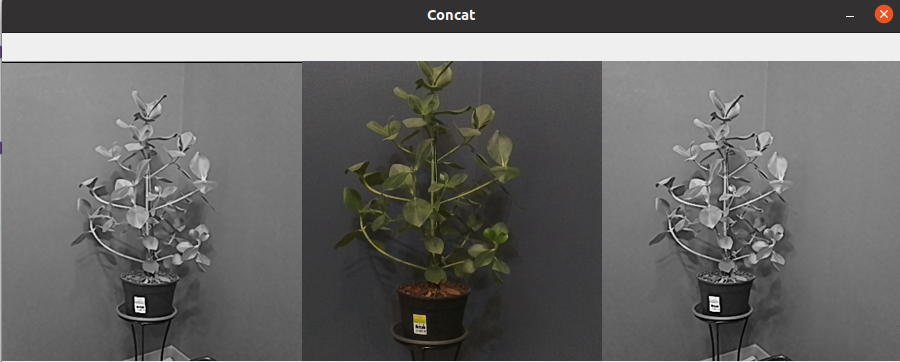Multi-Input Frame Concationation¶
Example concatenates all 3 inputs with a simple custom model created with PyTorch (link here, tutorial here). It uses NeuralNetwork’s multiple input feature and links all 3 camera streams directly to the NeuralNetwork node.
Demo¶

Setup¶
Please run the install script to download all required dependencies. Please note that this script must be ran from git context, so you have to download the depthai-python repository first and then run the script
git clone https://github.com/luxonis/depthai-python.git
cd depthai-python/examples
python3 install_requirements.py
For additional information, please follow installation guide
Source code¶
Also available on GitHub
1 2 3 4 5 6 7 8 9 10 11 12 13 14 15 16 17 18 19 20 21 22 23 24 25 26 27 28 29 30 31 32 33 34 35 36 37 38 39 40 41 42 43 44 45 46 47 48 49 50 51 52 53 54 55 56 57 58 59 60 61 62 63 64 65 66 | #!/usr/bin/env python3
from pathlib import Path
import sys
import numpy as np
import cv2
import depthai as dai
SHAPE = 300
# Get argument first
nnPath = str((Path(__file__).parent / Path('../models/concat_openvino_2021.4_6shave.blob')).resolve().absolute())
if len(sys.argv) > 1:
nnPath = sys.argv[1]
if not Path(nnPath).exists():
import sys
raise FileNotFoundError(f'Required file/s not found, please run "{sys.executable} install_requirements.py"')
p = dai.Pipeline()
p.setOpenVINOVersion(dai.OpenVINO.VERSION_2021_4)
camRgb = p.createColorCamera()
camRgb.setPreviewSize(SHAPE, SHAPE)
camRgb.setInterleaved(False)
camRgb.setColorOrder(dai.ColorCameraProperties.ColorOrder.BGR)
def create_mono(p, socket):
mono = p.create(dai.node.MonoCamera)
mono.setBoardSocket(socket)
mono.setResolution(dai.MonoCameraProperties.SensorResolution.THE_400_P)
# ImageManip for cropping (face detection NN requires input image of 300x300) and to change frame type
manip = p.create(dai.node.ImageManip)
manip.initialConfig.setResize(300, 300)
manip.initialConfig.setFrameType(dai.RawImgFrame.Type.BGR888p)
mono.out.link(manip.inputImage)
return manip.out
# NN that detects faces in the image
nn = p.createNeuralNetwork()
nn.setBlobPath(nnPath)
nn.setNumInferenceThreads(2)
camRgb.preview.link(nn.inputs['img2'])
create_mono(p, dai.CameraBoardSocket.CAM_B).link(nn.inputs['img1'])
create_mono(p, dai.CameraBoardSocket.CAM_C).link(nn.inputs['img3'])
# Send bouding box from the NN to the host via XLink
nn_xout = p.createXLinkOut()
nn_xout.setStreamName("nn")
nn.out.link(nn_xout.input)
# Pipeline is defined, now we can connect to the device
with dai.Device(p) as device:
qNn = device.getOutputQueue(name="nn", maxSize=4, blocking=False)
shape = (3, SHAPE, SHAPE * 3)
while True:
inNn = np.array(qNn.get().getFirstLayerFp16())
# Planar INT8 frame
frame = inNn.reshape(shape).astype(np.uint8).transpose(1, 2, 0)
cv2.imshow("Concat", frame)
if cv2.waitKey(1) == ord('q'):
break
|
Also available on GitHub
1 2 3 4 5 6 7 8 9 10 11 12 13 14 15 16 17 18 19 20 21 22 23 24 25 26 27 28 29 30 31 32 33 34 35 36 37 38 39 40 41 42 43 44 45 46 47 48 49 50 51 52 53 54 55 56 57 58 59 60 61 62 63 64 65 66 67 68 69 70 71 72 73 74 75 76 77 78 79 | #include <chrono>
#include <cstdio>
#include <iostream>
// Inludes common necessary includes for development using depthai library
#include "depthai/depthai.hpp"
#include "utility.hpp"
int main(int argc, char** argv) {
using namespace std;
// Default blob path provided by Hunter private data download
// Applicable for easier example usage only
std::string nnPath(BLOB_PATH);
// If path to blob specified, use that
if(argc > 1) {
nnPath = std::string(argv[1]);
}
// Print which blob we are using
printf("Using blob at path: %s\n", nnPath.c_str());
// Create pipeline
dai::Pipeline pipeline;
pipeline.setOpenVINOVersion(dai::OpenVINO::Version::VERSION_2021_4);
// Define sources and outputs
auto camRgb = pipeline.create<dai::node::ColorCamera>();
camRgb->setPreviewSize(300, 300); // NN input
camRgb->setInterleaved(false);
camRgb->setColorOrder(dai::ColorCameraProperties::ColorOrder::BGR);
auto right = pipeline.create<dai::node::MonoCamera>();
right->setCamera("right");
right->setResolution(dai::MonoCameraProperties::SensorResolution::THE_400_P);
auto manipRight = pipeline.create<dai::node::ImageManip>();
manipRight->initialConfig.setResize(300, 300);
manipRight->initialConfig.setFrameType(dai::ImgFrame::Type::BGR888p);
right->out.link(manipRight->inputImage);
auto left = pipeline.create<dai::node::MonoCamera>();
left->setCamera("left");
left->setResolution(dai::MonoCameraProperties::SensorResolution::THE_400_P);
auto manipLeft = pipeline.create<dai::node::ImageManip>();
manipLeft->initialConfig.setResize(300, 300);
manipLeft->initialConfig.setFrameType(dai::ImgFrame::Type::BGR888p);
left->out.link(manipLeft->inputImage);
auto nn = pipeline.create<dai::node::NeuralNetwork>();
nn->setBlobPath(nnPath);
nn->setNumInferenceThreads(2);
manipLeft->out.link(nn->inputs["img1"]);
camRgb->preview.link(nn->inputs["img2"]);
manipRight->out.link(nn->inputs["img3"]);
auto xout = pipeline.create<dai::node::XLinkOut>();
xout->setStreamName("nn");
nn->out.link(xout->input);
// Connect to device and start pipeline
dai::Device device(pipeline);
// Output queues will be used to get the rgb frames and nn data from the outputs defined above
auto qNn = device.getOutputQueue("nn", 4, false);
while(true) {
auto inNn = qNn->get<dai::NNData>();
cv::imshow("Concat", fromPlanarFp16(inNn->getFirstLayerFp16(), 900, 300));
int key = cv::waitKey(1);
if(key == 'q' || key == 'Q') {
return 0;
}
}
return 0;
}
|